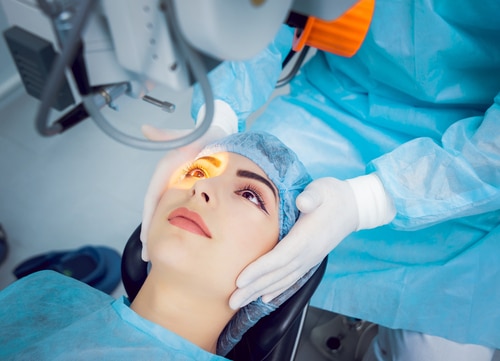Posted by: Manhattan LASIK Center
While many people are able to comfortably wear contact lenses long-term, some find correcting their vision with contact lenses intolerable. Wearing contact lenses can be even more challenging for individuals with dry eyes.
Fortunately, there are other highly effective options for achieving glasses-free, clear vision, including SMILE surgery. Keep reading to learn more about contact lens intolerance, dry eye, and how SMILE eye surgery can offer lasting relief for comfortable vision.
What Causes Contact Lens Intolerance?
Contact lens intolerance is a condition that occurs when the eyes can no longer tolerate wearing contact lenses comfortably. Symptoms of the condition can include dry, itchy eyes, redness, irritation, inflammation, pain, or discomfort when wearing lenses.
Intolerance can affect both new contact lens wearers and individuals who have been comfortably wearing lenses for many years. The condition can cause eye discomfort immediately after lenses have been inserted or after they have been worn for most of the day without an issue.
There are several causes of contact lens intolerance, including:
- Dry eye
- Improper use, storage, or cleaning
- Adverse reaction to cleaning or storage solution
- Improperly fitting lenses
- Allergies
Typically, the symptoms of contact lens intolerance tend to worsen over time, leaving wearers with fewer comfortable hours of use each day. While some individuals may find temporary relief by using eye drops or switching to a different lens, they may ultimately need to find a more permanent solution.
How Does Dry Eye Affect Contact Lens Intolerance?
Dry eye is one of the most common causes of contact lens intolerance. This condition occurs when the eyes don’t produce enough tears or when the tears evaporate too quickly.
Contact lens use can contribute to the development of dry eye over time. Wearing contact lenses can reduce oxygen flow to the cornea, disrupting the production of tears and the stability of moisturizing tear film.
Dry eye can cause the eyes to feel uncomfortably gritty, sticky, or tired while wearing contact lenses. Chronic dryness can also lead to inflammation, making the eyes even less tolerant of lenses and increasing the risk of serious corneal injuries, such as abrasions or ulcers.
Contact lens intolerance, often caused by the symptoms of dry eye, is one of the leading reasons lens wearers consider other options for vision correction. Many find that laser vision correction surgery, such as SMILE, is the most effective way to enjoy permanently clear and comfortable vision.
What is SMILE Laser Eye Surgery?
SMILE, which stands for Small Incision Lenticule Extraction, is a minimally invasive laser procedure that corrects vision by reshaping the cornea. It can correct nearsightedness and astigmatism.
During a SMILE surgery, a precision femtosecond laser is used to make an incision on the surface of the cornea. The same laser is used to create a disc-shaped piece of corneal tissue called a lenticule, which is removed through the incision.
Unlike other procedures, SMILE requires only a tiny incision, about 2-3 millimeters wide, to reshape the cornea and correct vision. This small incision leaves the surface of the cornea largely intact, allowing for faster healing and fewer post-surgery side effects.
Benefits of SMILE for Those with Contact Lens Intolerance and Dry Eyes
While the primary benefit of SMILE is that it can significantly reduce your need for contact lenses for clear vision, it also offers additional advantages, particularly for individuals with dry eyes. These include:
Reduced Impact on Corneal Nerves
SMILE is minimally invasive and has less of an impact on corneal nerves, which play a crucial role in the production and maintenance of tear film.
Fewer Side Effects
By preserving the corneal nerves, SMILE is less likely to cause the symptoms of dry eye during recovery.
Faster Recovery of Corneal Sensitivity
Studies show that corneal sensitivity, which is crucial for tear production, recovers more quickly after SMILE.
Less Risk of Complications
The risk of complications caused by existing dry eye is less after SMILE surgery.
Who is a Good Candidate for SMILE?
To be considered a good candidate for SMILE, you must be at least 18 years old and have an eye prescription that has been stable for at least a year. Your prescription should be between -1.5 and -10 diopters of nearsightedness and less than three diopters of astigmatism.
Other factors that can affect candidacy for SMILE include corneal thickness, eye health, and overall health. SMILE is usually not a safe option for individuals with unstable eye prescriptions, some existing eye conditions, or certain chronic health conditions that can affect recovery, such as diabetes and heart disease.
If contact lens intolerance and dry eye are making it impossible to correct your vision without relying on unwanted glasses, SMILE can help! By minimizing the symptoms of dry eye and restoring visual comfort, it provides patients with clear, crisp vision and lasting freedom from the discomfort associated with contact lenses.
Do you want to learn more about SMILE or determine if you might be a good candidate for the procedure? Schedule an appointment at Manhattan LASIK Center in Manhattan, NY, today!




